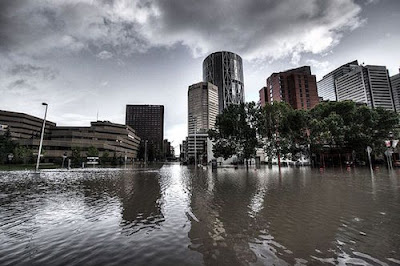 |
| Flooding - Climate Change |
While the relationship between a warmer world and a (catastrophically) wetter one has been confirmed at global and hemispheric levels, the Canadian study is one of the first to connect the dots at the continental level, reports CBC. In the study’s first step, the researchers showed that major downpours did increase at sites around the United States and Canada between 1961 and 2010. Then, they compared those observations to climate models that predicted such a trend for a warmer atmosphere.
“Sure enough, the observations and the models were consistent with one another,” CBC writes.
The study makes clear that the perceptible increase in both the frequency and severity of torrential downpours all over North America are “largely due to global warming,” said lead author and Environment Canada research scientist Megan Kirchmeier-Young. Critical among the findings, published last week in the Proceedings of the National Academy of Sciences, was the prediction that such rainstorms—along with the terrifying and economically devastating flash floods they generate—will grow far more frequent and far more fierce should average global warming be permitted to rise to 2.0°C.
Highly devastating storms are often called “once-in-a-century” events, but are now actually arriving about every 20 years—thanks to anthropogenic climate change, CBC notes. And at 2.0°C, these tempests will come down onto the heads of North Americans every five years. Lesser but still damaging storms will continue to increase in frequency, too: from the “every 20 years” of a century ago to every five years now—and, if warming is not halted, every second year in the future. Such a jump in destructive storm activity will add a significant financial burden on Canadians already suffering the fallout from the impacts of 1.0°C of warming, writes CBC.
Flooding is already “by far the No. 1 driver” of the catastrophic financial losses Canada is experiencing due to climate change, said Natalia Moudrak, director of climate resilience at the University of Waterloo Intact Centre on Climate Adaptation. Where extreme weather events led to average losses of less than C$500 million per year in the 1980s, since 2009 that number has exceeded $1 billion in every year but one.
“Water damages are rising in Canada, and it’s the elephant in the room,” Moudrak told CBC.
Policy-makers and the private sector are becoming increasingly alert to the growing crisis, and are already adapting by “updating things like stormwater management guidelines and zoning bylaws and investing in flood resilience retrofits,” she added. And the latest federal study only underscores just how important such work has become.
“It has to happen, and has to happen today,” Moudrak said.
From The Energy Mix